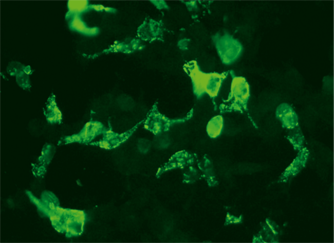Clinical information
Patients with autoimmune encephalopathies exhibit autoantibodies against neuronal cell surface antigens. The antibodies are directed against glutamate receptors (type NMDA or type AMPA), GABAB receptors, DPPX, voltage-gated potassium channels (VGKC) or VGKC-associated proteins (LGI1, CASPR2, TAG-1/ contactin-2). Since these antigens play a direct or indirect role in synaptic signal transduction, the associated autoimmunities manifest with seizures and neuropsychiatric symptoms. The resulting conditions include special forms of autoimmune limbic encephalitis, neuromyotonia or Morvan’s syndrome. These severe, potentially lethal syndromes can have a non-paraneoplastic or paraneoplastic aetiology. The frequency of underlying tumours ranges from 10 to 70%, depending on the type of antibody. The antibodies most likely play a causal role in the pathogenesis. Since appropriate therapy (immunomodulatory intervention, tumour resection) results in considerable regression of symptoms in most patients, early diagnosis is important for a favourable prognosis.
Diagnostics
 The diagnosis of autoimmune encephalitides is generally based on a combination of the characteristic clinical picture, supporting findings from brain MRT, EEG and CSF analysis if necessary, and antibody determination in serum/CSF. Monospecific recombinant assays are the method of choice for serological diagnostics and can be combined with conventional immunohistochemical detection procedures. The following conditions must be excluded by differential diagnostics: infectious encephalitides (especially HSV), other autoimmune aetiologies (e.g. limbic encephalitis with autoantibodies against Hu, Ma2, CV2, amphiphysin) and clinically similar diseases of the central and/or peripheral nervous system. A diagnostic discrimination from atypical encephalitides should also be taken into consideration. It should be taken into account that overlap syndromes and combinations of different syndromes can also occur. When a positive serological result is obtained, a comprehensive tumour investigation should be undertaken.
The diagnosis of autoimmune encephalitides is generally based on a combination of the characteristic clinical picture, supporting findings from brain MRT, EEG and CSF analysis if necessary, and antibody determination in serum/CSF. Monospecific recombinant assays are the method of choice for serological diagnostics and can be combined with conventional immunohistochemical detection procedures. The following conditions must be excluded by differential diagnostics: infectious encephalitides (especially HSV), other autoimmune aetiologies (e.g. limbic encephalitis with autoantibodies against Hu, Ma2, CV2, amphiphysin) and clinically similar diseases of the central and/or peripheral nervous system. A diagnostic discrimination from atypical encephalitides should also be taken into consideration. It should be taken into account that overlap syndromes and combinations of different syndromes can also occur. When a positive serological result is obtained, a comprehensive tumour investigation should be undertaken.


















 The diagnosis of autoimmune encephalitides is generally based on a combination of the characteristic clinical picture, supporting findings from brain MRT, EEG and CSF analysis if necessary, and antibody determination in serum/CSF. Monospecific recombinant assays are the method of choice for serological diagnostics and can be combined with conventional immunohistochemical detection procedures. The following conditions must be excluded by differential diagnostics: infectious encephalitides (especially HSV), other autoimmune aetiologies (e.g. limbic encephalitis with autoantibodies against Hu, Ma2, CV2, amphiphysin) and clinically similar diseases of the central and/or peripheral nervous system. A diagnostic discrimination from atypical encephalitides should also be taken into consideration. It should be taken into account that overlap syndromes and combinations of different syndromes can also occur. When a positive serological result is obtained, a comprehensive tumour investigation should be undertaken.
The diagnosis of autoimmune encephalitides is generally based on a combination of the characteristic clinical picture, supporting findings from brain MRT, EEG and CSF analysis if necessary, and antibody determination in serum/CSF. Monospecific recombinant assays are the method of choice for serological diagnostics and can be combined with conventional immunohistochemical detection procedures. The following conditions must be excluded by differential diagnostics: infectious encephalitides (especially HSV), other autoimmune aetiologies (e.g. limbic encephalitis with autoantibodies against Hu, Ma2, CV2, amphiphysin) and clinically similar diseases of the central and/or peripheral nervous system. A diagnostic discrimination from atypical encephalitides should also be taken into consideration. It should be taken into account that overlap syndromes and combinations of different syndromes can also occur. When a positive serological result is obtained, a comprehensive tumour investigation should be undertaken.